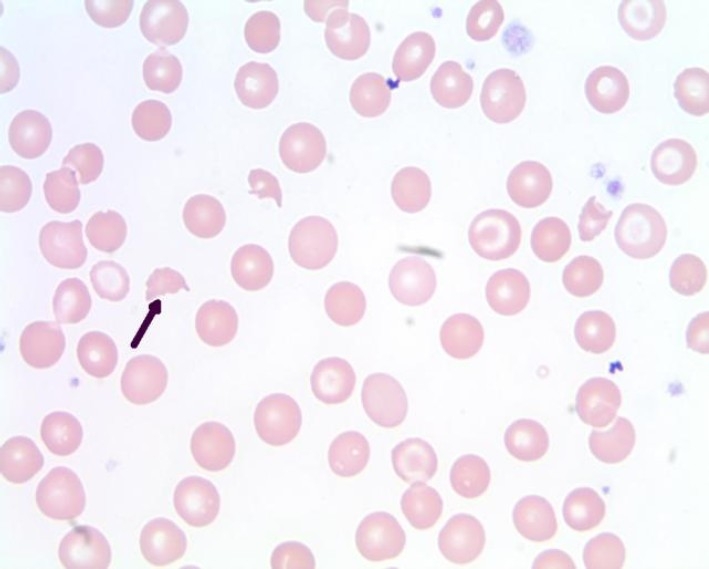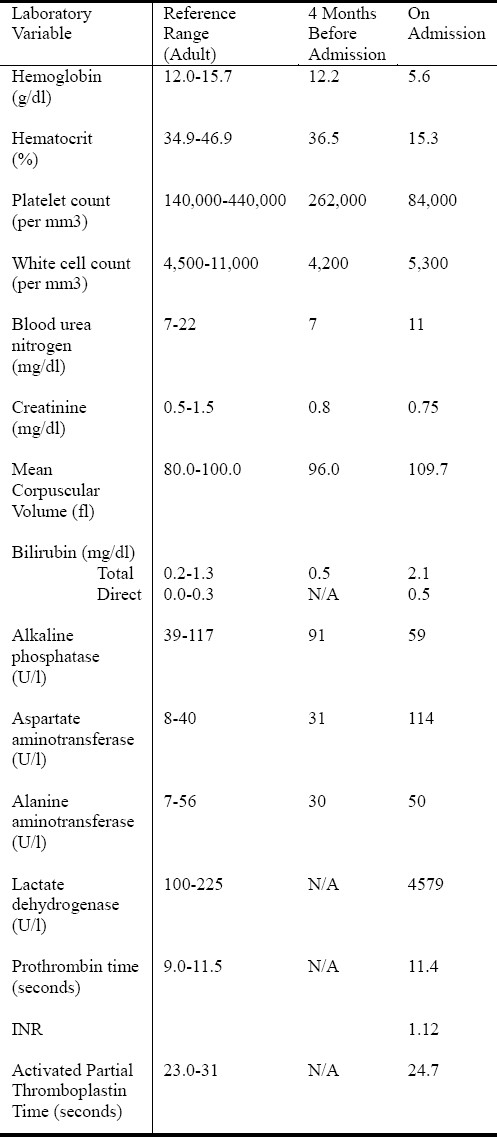Abstract
Context:
Schistocytes are fragmented red blood cells due to the flow of blood through damaged capillaries and indicate endothelial injury. They are typical of microangiopathic hemolytic anemia seen in life threatening conditions like disseminated intravascular coagulation or thrombotic thrombocytopenic purpura/hemolytic uremic syndrome .We report a rare sub-acute presentation of pernicious anemia with hemolysis, thrombocytopenia and numerous schistocytes that was initially diagnosed as a more serious thrombotic thrombocytopenic purpura.
Case Report:
A 31-year-old Caucasian woman presented with fatigue and paresthesia of both feet for 1 week. Past medical history included hypertension and gastro-esophageal reflux disease. Examination revealed scleral icterus and pallor. Examination of the abdomen did not show hepatosplenomegaly. Initial laboratory tests showed severe anemia, and low platelets. Indirect bilirubin and serum Lactate De Hydrogenase were elevated. Prothrombin time, partial thromboplastin time, serum fibrinogen, and serum fibrin degradation product levels were normal. Peripheral smear revealed numerous schistocytes, anisocytosis and macro-ovalocytes. Thrombotic thrombocytopenic purpura (TTP) was suspected due to the constellation of sub-acute onset of fatigue and paresthesia along with thrombocytopenia, schistocytes and an elevated LDH. Plasmapheresis was initiated for possible TTP. However, platelet count worsened despite plasmapheresis for 4 days. On re-evaluation, vitamin B12 was found to be low. Treatment with intra-muscular vitamin B12 led to symptomatic and hematologic improvement. Pernicious anemia was confirmed by the presence of anti-intrinsic factor antibodies, elevated serum gastrin level and atrophic gastritis.
Conclusion:
Clinicians must be aware of unusual clinical presentation of vitamin B12 deficiency with schistocytes as the management is simple and effective.
Keywords: Anemia, pernicious anemia, schistocytes
Introduction
Schistocytes are fragmented red blood cells due to the flow of blood through damaged capillaries and indicate endothelial injury[1]. They are typical of microangiopathic hemolytic anemia seen in life threatening conditions like disseminated intravascular coagulation (DIC) or thrombotic thrombocytopenic purpura (TTP)/hemolytic uremic syndrome (HUS)[1]. Pernicious anemia is a common cause of vitamin B12 deficiency. It develops gradually and presents as chronic hemolytic macrocytic anemia[2].
We report a rare sub-acute presentation of pernicious anemia with hemolysis, thrombocytopenia and numerous schistocytes that was initially diagnosed as a more serious TTP.
Case Report
A 31-year-old Caucasian woman presented with fatigue and paresthesia of both feet for 1 week. Past medical history included hypertension and gastro-esophageal reflux disease. Patient denied fever, shortness of breath, or weakness of legs. Patient had chronic diarrhea and weight loss of 5 lbs. over the past few months. Patient was taking lisinopril and ranitidine. Patient was allergic to penicillin. Patient drank alcohol occasionally, never smoked or used recreational drugs. Her sister had iron deficiency anemia and grandfather was treated for chronic myeloid leukemia.
Patient was a febrile, and hemodynamically stable. Patient had scleral icterus and pallor. Examination of the abdomen did not show hepatosplenomegaly. Neurological examination showed normal sensations and power in her lower extremities. Rest of the physical examination was normal.
Initial laboratory tests showed that hemoglobin was 5.7 g/dl, hematocrit 15.7%, platelet count was 81,000/mm3 and white blood cell count 4,200/mm3. Electrolytes and serum creatinine were normal. Total bilirubin was elevated at 2.2 mg/dl, and direct bilirubin was 0.5 mg/dl with normal liver enzymes. Serum Lactate De Hydrogenase (LDH) was elevated at 4579 U/l. Prothrombin time, partial thromboplastin time, serum fibrinogen, and serum fibrin degradation product levels were within normal limits. Coomb's test was negative. Peripheral smear revealed numerous schistocytes, anisocytosis and macro-ovalocytes (Figure 1). Laboratory data on the day of admission and 4 months prior to presentation are described in Table 1.
Fig. 1.

Peripheral smear (Arrow) showing schistocytes.
Table 1.
Laboratory values on admission compared to 4 months before admission

Thrombotic thrombocytopenic purpura (TTP) was suspected due to the presence of sub-acute onset of fatigue and paresthesia along with thrombocytopenia, schistocytes and an elevated LDH. Plasmapheresis was initiated for possible TTP. However, platelet count worsened to 42,000/mm3 despite plasmapheresis for 4 days.
On re-evaluation, vitamin B12 was 125 pg/mL (Normal 130-777 pg/mL), serum folate was 19 ng/mL (Normal 2.8-15.6 ng/mL), and methylmalonic acid was 6258 mmol/mL (Normal 73-376 mmol/mL). Iron studies were normal.
Treatment with intra-muscular vitamin B12 led to symptomatic and hematologic improvement. Pernicious anemia was confirmed by the presence of anti-intrinsic factor antibodies, elevated serum gastrin level 1578 pg/ml (normal 0-115 pg/ml). Upper gastrointestinal endoscopy revealed atrophic gastritis. At 4 month follow-up, our patient was symptom free with hemoglobin 12.4 g/dl and platelet count 248,000/mm3.
Discussion
Vitamin B12 is needed for the synthesis of Deoxy ribo Nucleic Acid (DNA) and division of blood cells. Deficiency of vitamin B12 leads to an arrest in the maturation of nucleated precursors and results in hemolysis in the bone marrow[3]. This manifests clinically as hemolytic anemia with indirect hyperbilirubinemia and an elevated serum LDH levels[3]. Serum LDH levels are higher in vitamin B12 deficiency[4] than peripheral hemolysis from TTP.
An increase in the RBC membrane rigidity and a decrease in erythrocyte deformability were reported in B12 deficiency[5]. Deficiency of Vitamin B12 also results in an elevated serum homocysteine[6]. High homocysteine in the serum causes endothelial dysfunction[6]. The biological effects of endothelial dysfunction are vasoconstriction, increased platelet aggregation, activation of coagulation system and monocyte adhesion to the endothelium[6]. This leads to fragmentation of erythrocytes to schistocytes as seen in our patient.
Schistocytes can also be seen in patients with preeclampsia, malignant hypertension, renal failure, mechanical heart valves, vitamin B12 deficiency and occasionally in normal individuals. Schistocytes are seen in life threatening conditions like TTP/HUS and DIC. TTP is differentiated from DIC by presence of normal coagulation parameters (prothrombin time, partial thromboplastin time, and serum fibrinogen).
Minimum daily requirement of vitamin B12 is 6 to 9 microgram/day. Since the total body stores of vitamin B12 are 2 to 5 mg, it usually takes years to develop vitamin B12 deficiency once its absorption ceases[2]. Rapid hematologic deterioration following exposure to nitrous oxide has been described in vitamin B12 deficient individuals[7,8]. Our patient denied any exposure to nitrous oxide.
Conclusion
Clinicians must be aware of unusual clinical presentation of vitamin B12 deficiency with schistocytes as the management is simple and effective.
References
- 1.Moake JL. Thrombotic microangiopathies. N Engl J Med. 2002;347(8):589–600. doi: 10.1056/NEJMra020528. [DOI] [PubMed] [Google Scholar]
- 2.Green R, Kinsella LJ. Current concepts in the diagnosis of cobalamin deficiency. Neurology. 1995;45(8):1435–1440. doi: 10.1212/wnl.45.8.1435. [DOI] [PubMed] [Google Scholar]
- 3.Aslinia F, Mazza JJ, Yale SH. Megaloblastic anemia and other causes of macrocytosis. Clin Med Res. 2006;4(3):236–241. doi: 10.3121/cmr.4.3.236. [DOI] [PMC free article] [PubMed] [Google Scholar]
- 4.Dalsania CJ, Khemka V, Shum M, et al. A sheep in wolf's clothing. Am J Med. 2008;121(2):107–109. doi: 10.1016/j.amjmed.2007.11.003. [DOI] [PubMed] [Google Scholar]
- 5.Ballas SK, Saidi P, Constantino M. Reduced erythrocytic deformability in megaloblastic anemia. Am J Clin Pathol. 1976;66(6):953–957. doi: 10.1093/ajcp/66.6.953. [DOI] [PubMed] [Google Scholar]
- 6.Nappo F, De Rosa N, Marfella R, et al. Impairment of endothelial functions by acute hyperhomocysteinemia and reversal by antioxidant vitamins. JAMA. 1999;281(22):2113–2118. doi: 10.1001/jama.281.22.2113. [DOI] [PubMed] [Google Scholar]
- 7.Schilling RF. Is nitrous oxide a dangerous anesthetic for vitamin B12-deficient subjects? JAMA. 1986;255(12):1605–1606. [PubMed] [Google Scholar]
- 8.Flippo TS, Holder WD., Jr Neurologic degeneration associated with nitrous oxide anesthesia in patients with vitamin B12 deficiency. Arch Surg. 1993;128(12):1391–1395. doi: 10.1001/archsurg.1993.01420240099018. [DOI] [PubMed] [Google Scholar]


